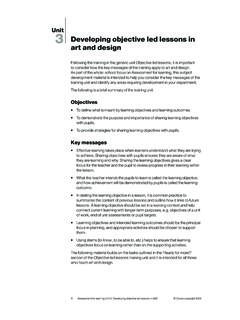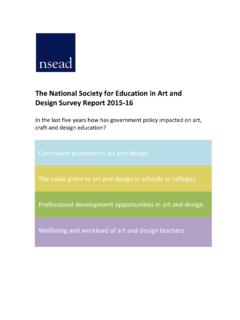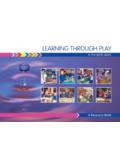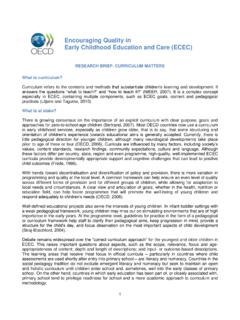Transcription of Art and design programme of study: Key stage 1-3
1 1 Art and design programme of study : Key stage 1-3 National curriculum in England: Key Department for Education (DfE) version (is in black text) NSEAD additional guidance is in blue, further guidance in green DfE Purpose of study Art, craft and design embody some of the highest forms of human creativity. A high- quality art and design education should engage, inspire and challenge pupils, equipping them with the knowledge and skills to experiment invent and create their own works of art, craft and design . As pupils progress, they should be able to think critically and develop a more rigorous understanding of art and design . They should also know how art and design both reflect and shape our history, and contribute to the culture, creativity and wealth of our nation.
2 NSEAD: The Importance of Art, Craft and design The NSEAD believes that a world class art, craft and design education provides and inspires personal expression, cultural understanding, creative and practical responses, promoting imaginative risk taking to provide solutions to our material, emotional, social and virtual worlds. A world class, art, craft and design education will engage, inspire and challenge pupils, equipping them with the knowledge and skills to participate in, experiment with, invent and create their own works of art, craft and design . Pupils should be able to think creatively and critically. They should investigate and evaluate a wide range of creative outcomes from the past and present to develop rigorous understanding of the many disciplines within art, craft and design and how they shape our history and future.
3 This will enable pupils to contribute as confident citizens and future professionals to the culture, creativity, economic success, leisure, material and emotional well being of our society within both national and global contexts. DfE Aims The national curriculum for art and design aims to ensure that all pupils: produce creative work, exploring their ideas and recording their experiences Generate ideas; a key strand of art, craft and design education is to help pupils generate and develop their own original ideas. To support their learning in this key strand pupils should: develop personal and creative responses through diverse opportunities to generate original ideas in a variety of ways and to use different media and processes 2 investigate, analyze, experiment and work expressively to explore and record their observations, imagination, feelings and personal responses when engaged in creative processes and when making outcomes become proficient in drawing, painting, sculpture and other art, craft and design techniques Make.
4 A key stand of all good art, craft and design education will be to help pupils to make their own work and to use materials and techniques purposefully. To support learning in this key strand pupils should: respond thoughtfully and act with purpose to develop skills, selecting and controlling suitable tools and systems with increasing proficiency to achieve intended outcomes have opportunities to work in a range of scales (from a small size to large scale works) in 2 and 3 dimensions and in virtual and time based media have opportunities to work in a variety of processes and media which could include: Drawing for different purposes, including perception, communication, invention and action - using a range of media such as charcoal, pencils of different grades (hard to soft), graphite sticks, colored pencils, oil pastels, chalk pastels.
5 Cont , crayons, wax, markers, fine-linerso, ball point pens, inventive mark making tools, ink pens, erasers and putty rubbers; Painting for different purposes and in different ways, exploring diverse techniques and processes such as wash, strokes, layers, blending, scumbling, spatter, drip, glaze, wet, dry, spray - using a range of media watercolour, tempera, oil, acrylic, gouache, ink, enamel, PVA and additives such as salt, sawdust, sand and collage materials, and including any natural products beetroot juice and natural dyes using a variety of tools different types of brush, sponge, fingers, hands, sticks, rollers, palette knives, spatulas and invented painting tools made from found and selected resources.
6 Printmaking using monoprint, lino, collograph, press print, screen, etching, intaglio hand printing with rollers and cloth wads, or using a roller, etching press, letter press or book binding press; Sculpture processes such as construction: using card, paper, wood, wire, structural armatures and surfaces using plaster of Paris, ModRoc, paper lamination/papier mach , found materials. Reduction and subtraction: with carving materials including soap, cast plaster, wood, stone. Modeling using materials such as modeling clay, air drying clay, salt dough, polymer clays, Plasticine, wax, Chavant, Newplast. Casting: using plaster of Paris or silicone rubber. New 3D technologies: using 3D printing and laser cutting and laser etching; Ceramics to develop functional, craft, sculptural or decorative outcomes using clay, cranked clay or slip casting; Creative Craft based outcomes exploring diverse processes that might include, jewelry , basket making, beadwork, toy making, mosaic, wood working and carving, enameling weaving, casting, and materials such as willow, papers, yarns, plastics, wire and metals, leather, clay, textiles or recycled or up cycled materials.
7 Collage using torn, cut and collected papers adding inks, paints, fabrics and found images, photographs and materials, as well as frottage and montage processes using photography, lens and digital light based media; Textiles to explore the properties of fabrics, textile materials and found materials to create visual and expressive outcomes in textile materials - design fashion and garments - construct functional or expressive/creative outcomes in fabric and malleable structural materials. Photography and lens based outcomes (photography, film and image capture) using chemical and/or digital recording, processing and printing systems as an art-form and as a means to support/inform other creative processes; Installation and site specific works including land art and earthworks, projected installations, interactive multi-media works, that may be temporary, semi-permanent or completely permanent and site specific; Digital and new media including, lens and light based media for web, screen and projection, digital drawing, painting, animation, design , interactive works and performances, digital installations and multi-media works.
8 design and graphic design for illustration, advertising, promotion, communication, virtual and printed publishing, packaging, styling, product design , typographic design . evaluate and analyze creative works using the language of art, craft and design Evaluate: A key strand of all good art, craft and design education is to help pupils evaluate, understand and improve their work. To support their learning in this key strand pupils should: review, think about and discuss their own work and the work of others, develop a critical and technical vocabulary relevant to art, craft and design and to creative, media and design industries 3 become visually perceptive and visually literate through looking, thinking, recognising, interpreting and understanding art, craft and design as a medium of communication and meaning which uses visual symbols and icons develop reading and writing skills alongside speaking and listening skills as they research, communicate, analyze, critically evaluate and review their own work and the work of significant artists, craftspeople.
9 Architects and designers know about great artists, craft makers and designers, and understand the historical and cultural development of their art forms. Knowledge: A key strand of all good art, craft and design education is to help pupils acquire knowledge and understanding of the world of art, craft and design . To support their learning in this key strand pupils should: develop and apply their reading and writing skills alongside their speaking and listening skills as they research, communicate, analyze, critically evaluate and review the work of significant artists, craftspeople, architects, film makers and designers learn about, research and explore relevant and significant artists, craftspeople, architects, film makers and designers to inform their creative thinking and the development of their own creative practice, informing their outcomes and signposting to career and vocational paths have opportunities to explore the work of artists, crafts people, architects.
10 Film makers and designers that should include examples selected from both male and female practitioners, examples from diverse genres, periods and cultures, exploring a range of different intentions and including examples selected from physical and virtual forms of expression Artists to include painters, portrait artists, landscape artists, abstract and conceptual artists, print makers, illustrators and graffiti artists all from different world cultures, periods or artistic movements Crafts people potters, ceramicists, weavers, jewelers, glass makers, furniture makers, textile artists in weave and print, stone masons, letter cutters, toy and automata makers and craftspeople working in traditional, cultural and heritage industry craft forms to include preservation and conservation.










